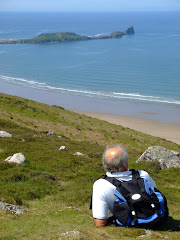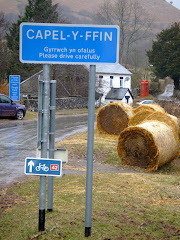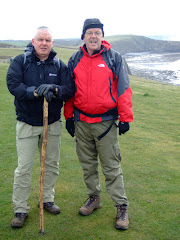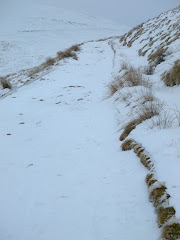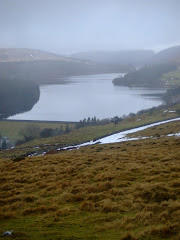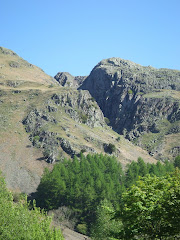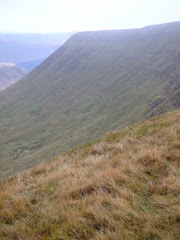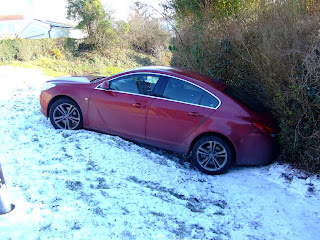
This was the tricky problem facing a neighbour early this morning, when his Vauxhall slid down a bank near his house.
Needless to say he needed a breakdown truck to extract the car from its 'off piste' slalom run into the waiting hedge.











 This particular section starts at the Community Centre and alongside St. Johns Church is a very narrow path that very soon crosses a bridge over the A465.
This particular section starts at the Community Centre and alongside St. Johns Church is a very narrow path that very soon crosses a bridge over the A465.










 Samuel Homfray (a local ironmaster) was so impressed with Trevithick's locomotive that he made a bet with another ironmaster, Richard Crawshay, for 500 guineas that Trevithick's steam locomotive could haul 10 tons of iron along the Merthyr Tydfil Tramroad from Penydarren to Abercynon, a distance of 9.75 miles (16 km). Amid great interest from the public, on 21 February 1804 it successfully carried 10 tons of iron, 5 wagons and 70 men the full distance in 4 hours and 5 minutes, an average speed of approximately 2.4 mph (3.9 km/h)
Samuel Homfray (a local ironmaster) was so impressed with Trevithick's locomotive that he made a bet with another ironmaster, Richard Crawshay, for 500 guineas that Trevithick's steam locomotive could haul 10 tons of iron along the Merthyr Tydfil Tramroad from Penydarren to Abercynon, a distance of 9.75 miles (16 km). Amid great interest from the public, on 21 February 1804 it successfully carried 10 tons of iron, 5 wagons and 70 men the full distance in 4 hours and 5 minutes, an average speed of approximately 2.4 mph (3.9 km/h) The nature reserve, where herons, otters, foxes and kingfisher can be seen, must be a twitchers delight with the large number of native British birds that were seen during this brief section.
The nature reserve, where herons, otters, foxes and kingfisher can be seen, must be a twitchers delight with the large number of native British birds that were seen during this brief section.











 On the short journey between Abercanaid and Troedyrhiw I passed the Dynevor Arms but it was still too early to open its doors! The majority of people that I passed were all out for an early morning walk with their dogs, which was precisely what former Plymouth Ward Councillor Ron Clarke was doing when I was passing him. We walked together for half a mile talking about various things before I also met someone that I used to work with a few years ago who was walking her parents dog - the shy but extremely handsome, Maxie.
On the short journey between Abercanaid and Troedyrhiw I passed the Dynevor Arms but it was still too early to open its doors! The majority of people that I passed were all out for an early morning walk with their dogs, which was precisely what former Plymouth Ward Councillor Ron Clarke was doing when I was passing him. We walked together for half a mile talking about various things before I also met someone that I used to work with a few years ago who was walking her parents dog - the shy but extremely handsome, Maxie.


 One of our local Police Sergeants, Richie Gardiner 37, has taken on one of the toughest physical challenges in Europe and won, setting a new course record in the process. Gardiner, who has represented Wales at various distance events over the years, beat 1,300 other entrants who came from 16 countries, to triumph on the course regarded by many as Europe’s most demanding marathon.
One of our local Police Sergeants, Richie Gardiner 37, has taken on one of the toughest physical challenges in Europe and won, setting a new course record in the process. Gardiner, who has represented Wales at various distance events over the years, beat 1,300 other entrants who came from 16 countries, to triumph on the course regarded by many as Europe’s most demanding marathon. Rock UK, have recently re-opened the Centre and have extensive expansion plans during 2011, that will include development of the site to accommodate exciting outdoor adventure activities including an extended high ropes course, low ropes and archery and further extension of the already substantial residential accommodation.
Rock UK, have recently re-opened the Centre and have extensive expansion plans during 2011, that will include development of the site to accommodate exciting outdoor adventure activities including an extended high ropes course, low ropes and archery and further extension of the already substantial residential accommodation.  Rock UK also plans to run water based activities at the Taff Bargoed Millenium Park which will include open canoeing, kayaking and raft building.
Rock UK also plans to run water based activities at the Taff Bargoed Millenium Park which will include open canoeing, kayaking and raft building.



